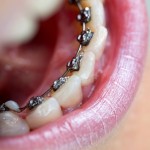
Almost all orthodontic patients receive some form of retainer following active treatment as orthodontic relapse is common. Studies suggest that a number of factors may be linked to relapse eg. retention protocol, patient compliance, age, and final occlusion after treatment. Retention strategies usually include removable and fixed retainers, with the latter having the advantage of minimal need for patient compliance. The aim of this review was to assess lingual retainer failures and to identify factors that influence the risk of failure of fixed orthodontic retainers.
Methods
Searches were conducted in Medline, Embase, the Cochrane Oral Health Group’s Trials Register, CENTRAL, ClinicalTrials.gov, the National Research Register, and Pro-Quest Dissertation Abstracts and Thesis database. Randomised clinical trials (RCTs), controlled clinical trials (CCTs) and retrospective studies of all types of fixed retainers were considered. Outcomes of interest were loosening, breakage and bond failure.
Two reviewers independently selected studies, extracted data and assessed study quality. RCTs were assessed with the Cochrane risk of bias tool and retrospective studies were graded A, B or C using the Bondemark scoring system (A= high value of evidence; B= moderate and C= low). The Grading of Recommendations Assessment, Development and Evaluation (GRADE) was use to assess the overall quality of evidence for the studies included in the meta-analysis.
Results
- 27 studies (9 RCTs; 6 prospective and 12 retrospective studies.) were included.
- 3 RCTs were considered to be at low risk of bias; 2 unclear risk and 4 at high risk.
- All 6 prospective studies were considered to be at high risk of bias.
- 5 retrospective studies were considered to provide a moderate level of evidence and 7 a low level of evidence.
- Substantial differences in the interventions, participants, and outcomes among studies were observed.
- Quantitative analysis was only feasible between polyethylene woven ribbon versus multi-stranded wire retainers.
- 4 studies (3 RCTs; I prospective study) assessed glass-fibre retainers reporting bond failures from 11 to 71%.
- 20 studies (9 RCTs; 2 prospective; 9 retrospective) evaluated multistranded retainers- reporting failures ranging from 12 to 50%.
- One comparison was performed, multi-stranded wires vs. polyethylene woven ribbon finding no statistically significant difference. RR= 1.74; (95% CI: 0.45 to 6.73; p=0.42).
Conclusions
The authors concluded: –
Despite the numerous studies dealing with parameters of fixed retention in orthodontics there is a lack of evidence on the selection of the optimal protocol and materials for fixed orthodontic retention.
Comments
The authors have search a good range of databases only identifying a small number of RCTs and prospective studies. They have also chosen to include retrospective studies and while these have been assessed for quality there is always a concern that these studies designs are more prone to bias. Within the included studies the authors highlight significant heterogeneity in relation to the interventions and the time points of outcome assessment. The one meta-analysis that was conducted in this review included 2 small studies and found no differences which is not unsurprising. A 2006 Cochrane review (Littlewood et al) considered all types of post-orthodontic retention. They were only able to include 5 trials concluding: –
There are insufficient research data on which to base our clinical practice on retention at present. There is an urgent need for high quality randomised controlled trials in this crucial area of orthodontic practice.
While this new review has included a 6 trials published since 2006 the quality of the available evidence for retention is low and the authors of this new review again call for high quality studies to be conducted on this important aspect of orthodontic treatment.
Links
Iliadi A, Kloukos D, Gkantidis N, Katsaros C, Pandis N. Failure of fixed orthodontic retainers: A systematic review. J Dent. 2015 May 13. pii: S0300-5712(15)00109-8. doi: 10.1016/j.jdent.2015.05.002. [Epub ahead of print] Review. PubMed PMID: 25979824.
Littlewood SJ, Millett DT, Doubleday B, Bearn DR, Worthington HV. Retention procedures for stabilising tooth position after treatment with orthodontic braces. Cochrane Database of Systematic Reviews 2006, Issue 1. Art. No.: CD002283. DOI: 10.1002/14651858.CD002283.pub3.

Little evidence on best fixed orthodontic retention methods. http://t.co/svVYCy1GSy
Orthodontic retention little evidence on fixed retention. http://t.co/svVYCy1GSy
Lack of evidence on fixed orthodontic retention. Methods. http://t.co/svVYCy1GSy
Lingual orthodontic retainers-lack of evidence. http://t.co/svVYCy1GSy
Don’t miss -Lingual retainers after orthodontic treatment- a lack of evidence. http://t.co/svVYCy1GSy